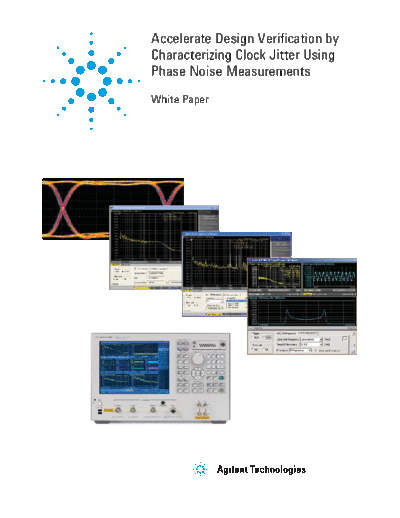Service Manuals, User Guides, Schematic Diagrams or docs for : HP Publikacje 5989-9849EN
<< Back | HomeMost service manuals and schematics are PDF files, so You will need Adobre Acrobat Reader to view : Acrobat Download Some of the files are DjVu format. Readers and resources available here : DjVu Resources
For the compressed files, most common are zip and rar. Please, extract files with Your favorite compression software ( WinZip, WinRAR ... ) before viewing. If a document has multiple parts, You should download all, before extracting.
Good luck. Repair on Your own risk. Make sure You know what You are doing.
Image preview - the first page of the document

>> Download 5989-9849EN documenatation <<
Text preview - extract from the document
Accelerate Design Verification by
Characterizing Clock Jitter Using
Phase Noise Measurements
White Paper
Introduction Clock jitter analysis has become more necessary as data rates have increased.
In high-speed serial data links clock jitter affects data jitter at the transmitter,
in the transmission line, and at the receiver. Measurements of clock quality
assurance have also evolved; now the emphasis is on directly relating clock
performance to system performance in terms of the bit error ratio (BER).
This white paper reviews the role of the reference clock, the effect of clock
jitter on data jitter, and discusses a new measurement technique using the
Agilent E5001A precision clock jitter analysis application on the E5052B
signal source analyzer (SSA). This new method of measurement delivers
unprecedented measurement accuracy for ultra-low random jitter (RJ)
measurements and real-time jitter spectrum analysis on both the RJ and
periodic jitter (PJ) of components, enabling you to improve your design quality.
A real-time measurement capability of the new solution that speeds up your
design verification process is also discussed.
The role of reference Figure 1 shows the major components of a high-speed serial data link. The
transmitter usually serializes a set of lower rate parallel signals into a serial
clocks in high-speed data stream. The transmission channel through which the signal propagates is
serial applications a combination of backplanes and cables. The receiver interprets incoming serial
data, re-clocks it and, usually, de-serializes it back into a parallel data stream.
In many high-speed serial communication systems, the reference clock is
considered more of a constituent than a key player, but in high-speed serial
data systems where system bit-rate can be in the multi-gigabit range, the
reference clock becomes a key component. Typically the reference clock
oscillates at a rate much lower than the data rate and is multiplied up in the
transmitter. The transmitter uses the reference clock to define the timing of
logic transitions in the serial data stream. The character of the reference clock
is included in the data transmitted. At the receiver, two different things can
happen. If the reference clock is not distributed, then the receiver recovers a
clock from the data stream ◦ Jabse Service Manual Search 2024 ◦ Jabse Pravopis ◦ onTap.bg ◦ Other service manual resources online : Fixya ◦ eServiceinfo